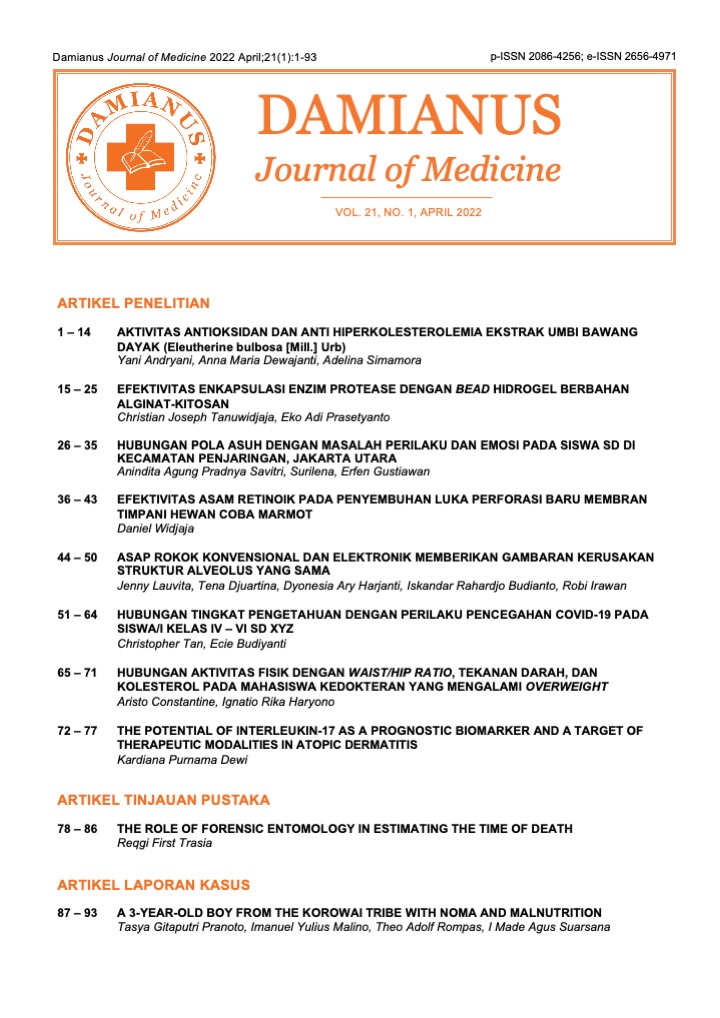A 3-YEAR OLD BOY FROM KOROWAY TRIBE WITH NOMA AND MALNUTRITION
DOI:
https://doi.org/10.25170/djm.v21i1.2982Keywords:
NOMA, Koroway, malnutrition, tropical disease, infectionAbstract
Background:
Noma is a rare infectious disease that rapidly destroys the soft tissues, perforating the hard tissues and the skin of the face. It was first named in the eighteenth century. Children aged between 2 and 6 years with poor oral hygiene, malnutrition, malaria, HIV infection, measles, living in a poor condition, and resource-constrained areas are at risk of the disease. This case emphasized the needs of greater understanding not only of the disease but also the multifactorial approach to attain health.
Case Presentation Summary:
A 3 year-old boy from Koroway was admitted with a month history of a lesion on the left cheek. The lesion had started as a vesicle on the left gum, progressing rapidly into an ulcer. At present, there was a hole on the left cheek. An ulcer with diameter of 5 cm, a greyish black area and edema appears on the external surface of the cheek, mandibular bone and teeth exposed. Associated with the lesion was pain, pus, malnutrition, no immunization records, and has a past history of recently malaria. The patient was living with his parents, a brother, and a sister in the tree house at Koroway.
Physical examination revealed pale conjunctiva and ronkhi at the basal of the lungs. His height was 89 cm, weighed 10 kg which showed thinness. Laboratory findings were microcytic hypochromic anemia, elevated erythrocyte sedimentation rate, normal leukocytes, and hypoalbuminemia, Mantoux test was negative and no HIV infection was found.
The patient was managed by blood transfusion, administration of antibiotics, debridement of the affected area, and putting on a high carbohydrate and protein diet, which was local foods such as bananas, eggs, and sago. After the lesion was smaller and no other complication revealed, the patient was discharged.
Learning Points/Discussion:
NOMA is an abandoned disease and known as the “face of poverty”. Early intervention can be made to minimize tissue destruction. Nevertheless, adequate steps regarding the availability, accessibility, and utilization of the resources with cultural approach might help to improve the health condition of individuals living in susceptible areas.
Downloads
References
2. Noma: a neglected enigma. Marck KW. Lancet Glob Health. 2013 Aug; 1(2):e58-e59.
3. Microarray analysis of microbiota of gingival lesions in noma patients. Huyghe A, François P, Mombelli A, Tangomo M, Girard M, Baratti-4. Mayer D, Bolivar I, Pittet D, Schrenzel J, Geneva Study Group on Noma. PLoS Negl Trop Dis. 2013; 7(9):e2453.
5. Risk factors for noma disease: a 6-year, prospective, matched case-control study in Niger.Baratti-Mayer D, Gayet-Ageron A, Hugonnet S, François P, Pittet-Cuenod B, Huyghe A, Bornand JE, Gervaix A, Montandon D, Schrenzel J, Mombelli A, Pittet D, Geneva Study Group on Noma (GESNOMA). Lancet Glob Health. 2013 Aug; 1(2):e87-e96.
6. Ashok, N., Tarakji, B., Darwish, S., Rodrigues, J. C., & Altamimi, M. A. (2015). A Review on Noma: A Recent Update. Global journal of health science, 8(4), 53–59. https://doi.org/10.5539/gjhs.v8n4p53














